The deep sea covers over 95% of Earth’s living space. And most of it remains a mystery. In the vast Pacific Ocean, you’ll find a fascinating array of deep-sea organisms, some of which have been recently discovered. Let’s talk about the elusive snailfish, for example. It’s a sneaky little creature that has evaded scientists for years, but they finally caught it on tape! And that’s not all; recently, there was a discovery of 5,000 new species in the Pacific Ocean—strange-looking creatures like the gummy squirrel.
What else lives at the bottom of the Pacific Ocean? From sea spiders to colossal squids, tube worms to cookie-cutter sharks, the ocean’s depths are full of surprises. So, join us on this incredible journey as we dive deeper and deeper, and even deeper, to discover the secrets of life at the bottom of the Pacific Ocean.
What Is the Pacific Ocean?
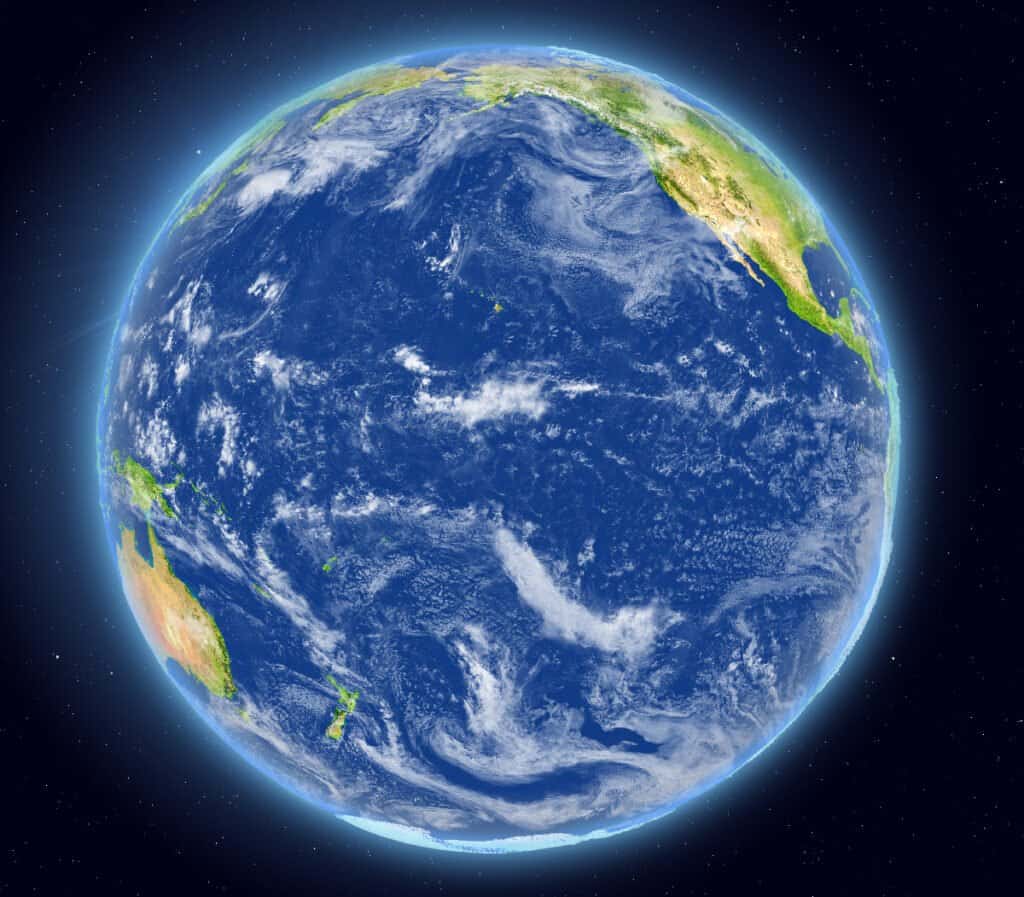
The Pacific Ocean covers over 30% of the Earth’s surface.
©Harvepino/Shutterstock.com
The Pacific Ocean is the largest and deepest ocean on Earth. It covers over 60 million square miles and over 30% of the Earth’s surface. More than half of the Earth’s open water supply is in the Pacific Ocean. And it’s bigger than all the land on Earth put together. The Pacific Ocean also holds nearly twice as much water as the Atlantic Ocean, the second-largest ocean.
Despite its size, the waters in the Pacific Ocean can seem very calm. Its name, “Pacific,” came from explorer Ferdinand Magellan in 1520. “Pacific” is a word that means peaceful, and Magellan used this name to describe the calmness of the water when he was there.
How deep does the ocean go? The average depth of the Pacific Ocean is about 13,000 feet. It also includes the deepest place on Earth — the Mariana Trench. This trench reaches 36,201 feet at a point known as the Challenger Deep. To put it in perspective, the Grand Canyon only has a depth of 6,093 feet. That means the deepest part of the Pacific Ocean is nearly six times deeper than the Grand Canyon.
Why is the Pacific Ocean So Deep?

The Pacific Ocean’s “Ring of Fire” is renowned for its frequent volcanic eruptions and seismic activity.
©Jag_cz/Shutterstock.com
The Pacific Ocean is the largest and deepest ocean in the world. But why? There are a few different reasons. For starters, surrounding the Pacific Ocean is the legendary “Ring of Fire.” This area is a hotspot for volcanic eruptions and seismic activity, like earthquakes.
The Pacific Ocean’s depth is also due to tectonic activity and subduction. Tectonic activity refers to the movement and interaction of large pieces of the Earth’s outer shell, called tectonic plates. Subduction is a type of plate movement where one plate goes underneath another plate and sinks into the Earth’s mantle. The denser, thinner oceanic crust leads to subduction when plates collide, forming trenches like the Mariana Trench.
What Lives at the Bottom of the Pacific Ocean?
In the depths of the Pacific Ocean, you can find a wide range of creatures. Some appear to come right out of a horror movie. Take, for instance, the vampire squid. This deep dweller has red eyes, a dark-colored body, and webbing between its arms. Vampire squids use bioluminescent displays to communicate and defend themselves from large fish, sharks, whales, and even sea lions.
Tripod Fish
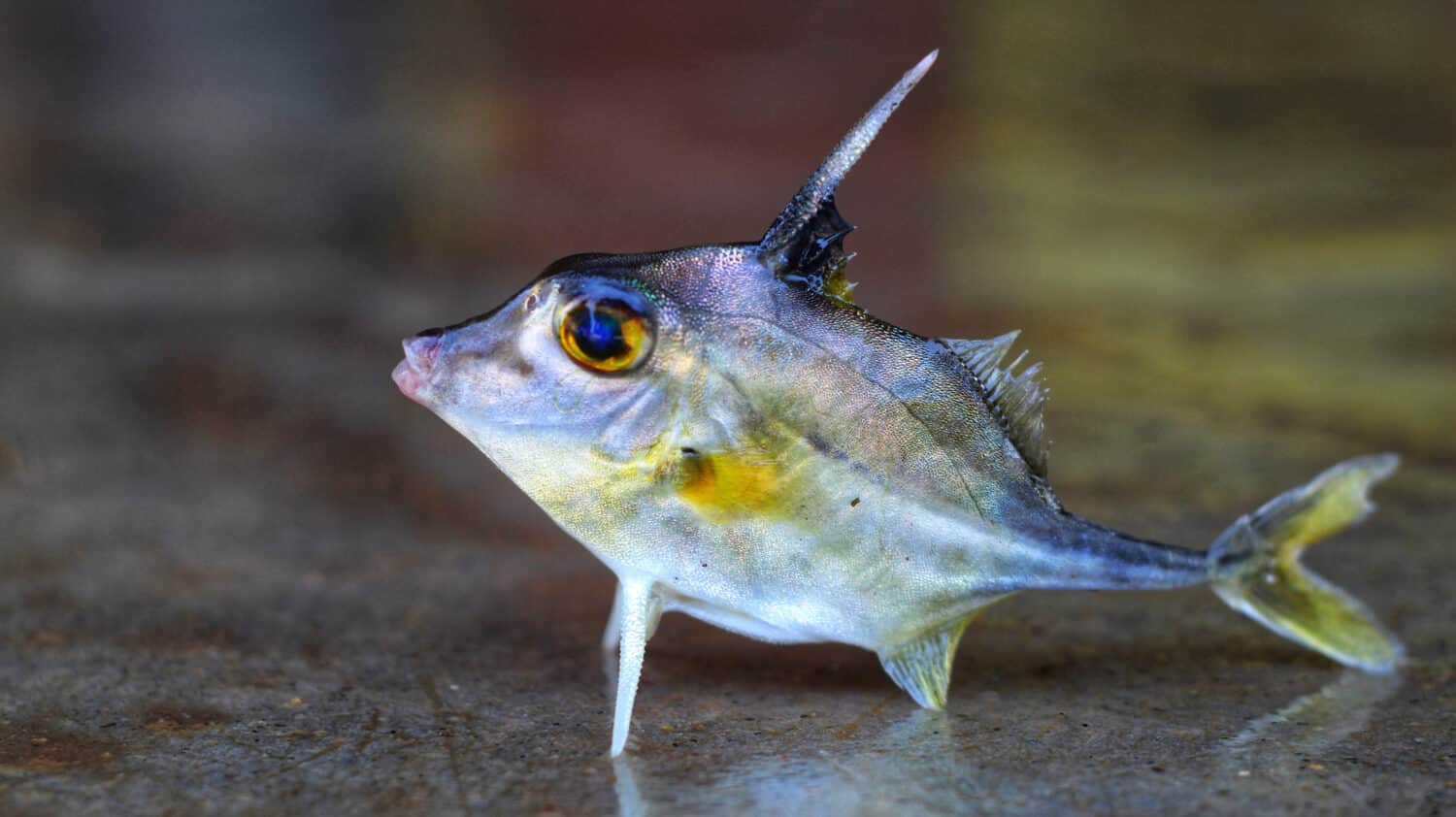
Tripod fish can live at depths of over 6,000 feet
©Biswaphotography93/Shutterstock.com
Another strange-looking fish at the bottom of the ocean is the tripod fish. Capable of living at depths of over 6,000 feet, tripod fish live up to their name. They use their elongated pectoral and pelvic fins to stand on the seafloor, like their own built-in tripod. They also have small, upward-facing eyes adapted for spotting prey above them.
Rattail Fish
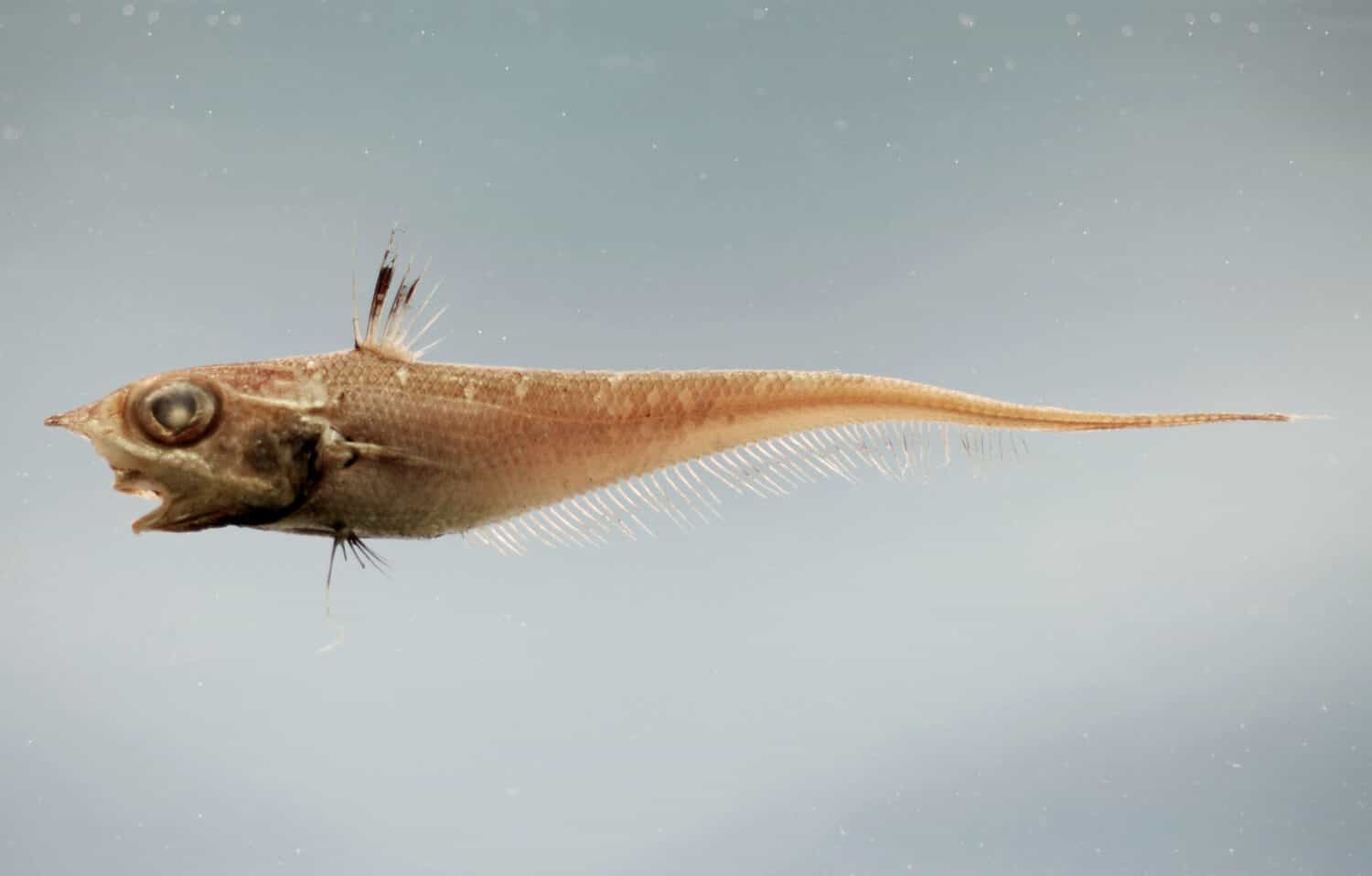
Rattail fish, also called grenadiers, can survive at depths of 22,967 feet.
©lego 19861111/Shutterstock.com
Capable of surviving at depths of 22,967 feet, rattail fish, also called grenadiers, are one of the deepest-dwelling fish around. They have elongated bodies and a long, tapering tail. Their diet consists of small fish, squid, and crustaceans.
In the Hadal zone of the ocean, the deepest area, there are abyssal grenadiers. These fish have huge heads and long bodies that can reach up to 3 feet long. Their mouth is filled with razor-sharp teeth, and their coloration helps them blend in perfectly with their environment. Their prey never even see them coming.
Octopus
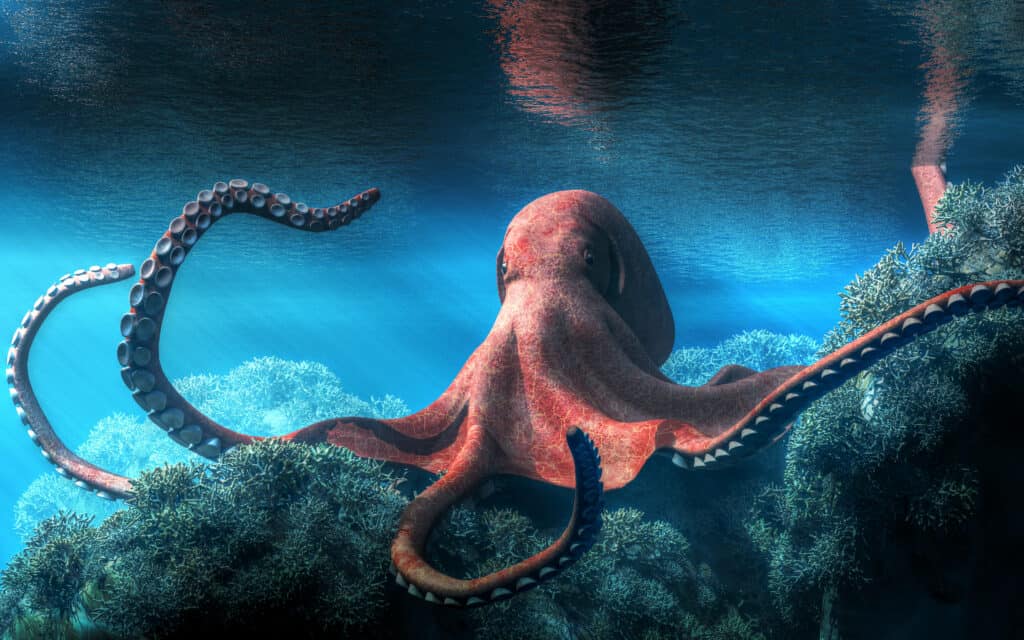
Certain species of octopus live at ocean depths of 23,000 feet.
©Daniel Eskridge/Shutterstock.com
Known as highly intelligent creatures, certain species of octopuses can live 23,000 feet deep. And some of them look like characters right out of a movie. Take, for instance, the dumbo octopus. This small deep-dwelling creature has ear-like fins resembling Disney’s Dumbo and resides at depths of 3,000 to 13,000 feet.
Zombie Worm

Zombie worms can live up to 13,000 feet deep and feed on whale bones.
©Gilda Villarreal/Shutterstock.com
Instead of brains, zombie worms feed on bones. Also known as Osedax, zombie worms eat the bones of whale carcasses. And they do this in depths of up to 13,000 feet. Since they lack a mouth and digestive system, they rely on symbiotic bacteria to break down the boney material.
Dragonfish
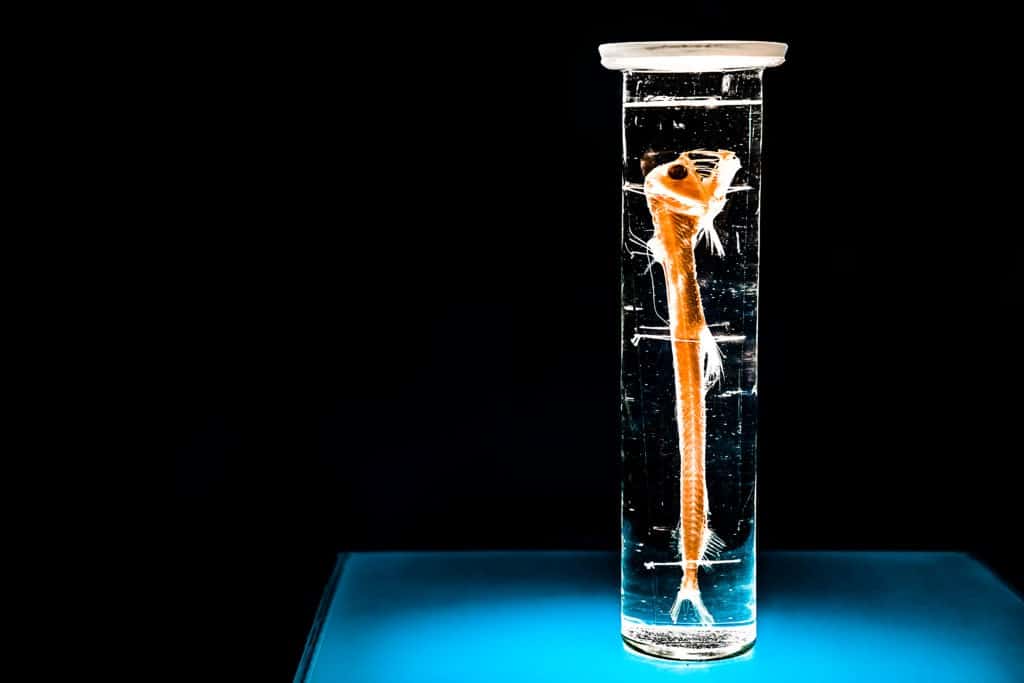
Dragonfish
can live up to 4,921 feet deep in the Pacific Ocean.
©OZGIOUN SAMPRI/Shutterstock.com
Another deep-sea dweller is the dragonfish, which can survive at depths of 4,921 feet. They have specialized adaptations for surviving in dark and deep waters. Some species of dragonfish produce bioluminescent light to attract prey or communicate. Bioluminescence is the emission of light by living organisms due to chemical reactions within their bodies. Dragonfish can even control the intensity and color of their bioluminescent light.
Fangtooth

Fangtooth
fish can live up to 16,000 feet deep.
©3DMI/Shutterstock.com
Recognizable by its long, fang-like teeth and menacing appearance, the fangtooth lives at depths of over 16,000 feet. It’s one of the deepest-dwelling fish in the world. This strange creature is unable to close its mouth due to its long fang-like teeth.
Anglerfish
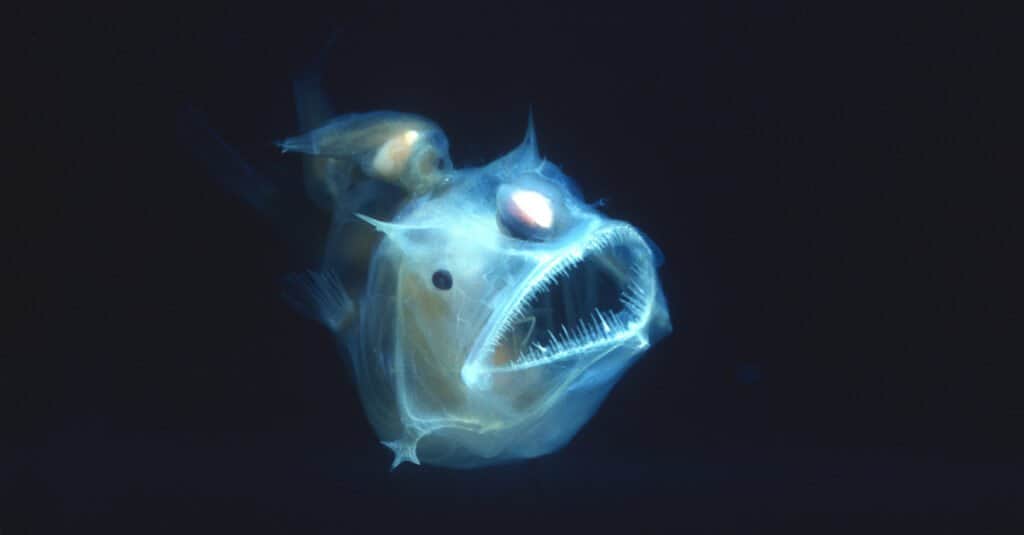
Anglerfish can live 4,835 feet deep in the Pacific Ocean.
©Neil Bromhall/Shutterstock.com
Living over 4,000 feet below the ocean’s surface, anglerfish are spooky and intriguing. They’re one of the more well-known deep-sea creatures. The females of this species have a fishing pole-like spine to lure prey and attract mates.
More Deep Dwelling Creatures
The depths of the Pacific Ocean are also inhabited by various creatures such as the pelican eel, hatchet fish, squid, sponges, comb jellies, pink seethrough fantasia, blob sculpin, goblin shark, proboscis worm, and giant isopods. And there’s also the frilled shark, who swims like a serpent. The frilled shark earns its name from the frilly appearance of its gill slits. It’s a deep-water species that occasionally venture as deep as 4,921 feet.
Rare Animals of the Pacific Ocean
Some of the rarest animals live in the depths of the Pacific Ocean. And certain species, like the abyssal gummy squirrel, were only recently discovered. The abyssal gummy squirrel doesn’t look much like a squirrel, but it does have a long tail. Its total body length is about 60 centimeters long. This creature is a type of sea cucumber and lives in the abyssal plains of the Clarion Clipperton Zone. This zone is an area beneath the Pacific Ocean where the Earth’s crust has fractured.
Basket Star

Basket stars feed by using their branch-like arms to capture drifting plankton.
©Pinosub/Shutterstock.com
Another pretty bizarre deep sea creature is the basket star. Resembling a mix between a starfish and a spider, they have a central disk with long, slender arms branching outward. They feed by using their branching arms to capture drifting plankton. In terms of habitat, they are typically found near the Pacific coast of North America and the Bering Sea. Remarkably, they can survive at depths of over 6,000 feet and have a lifespan of up to 35 years.
Giant Tube Worm
The giant tube worm lives on the ocean floor near hydrothermal vents. It can endure high pressure and frigid temperatures. This deep-dwelling critter can grow over 7 feet long, a length they reach in less than two years.
Snailfish Caught on Tape for the First Time
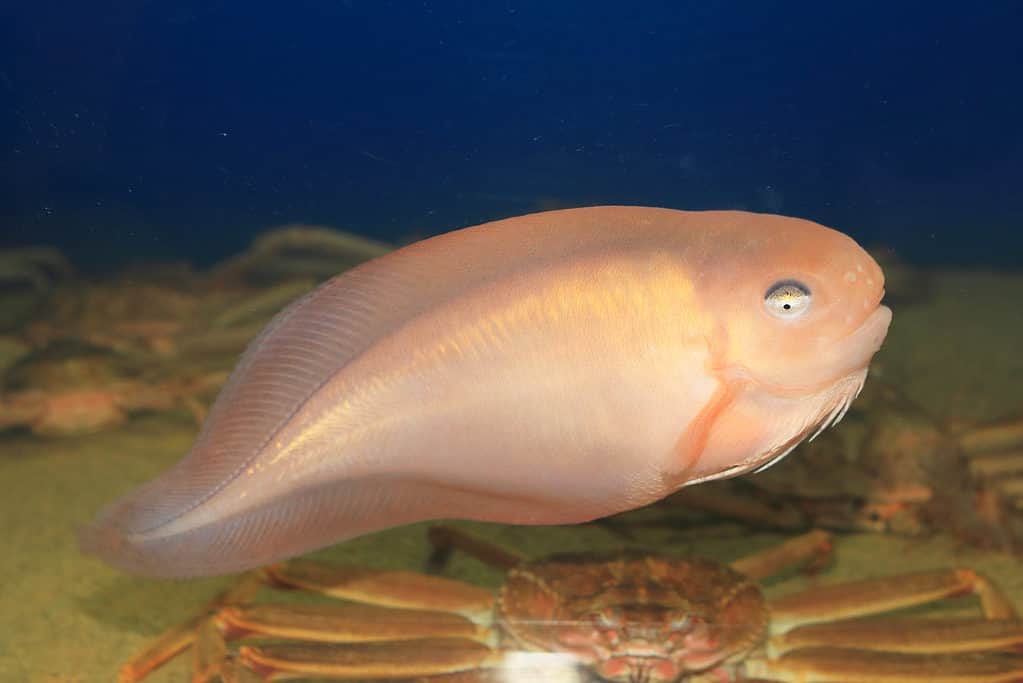
Certain species of snailfish can survive 26,716 feet below sea level.
©feathercollector/Shutterstock.com
Scientists finally filmed the deepest fish ever recorded — the snailfish. They caught the footage using a camera system attached to a weighted frame known as a lander, which attracted the fish.
Snailfish, specifically the deep-sea snailfish, have been identified as the deepest living fish ever documented. Among the various snailfish species, the Mariana snailfish stands out as it holds the record for the deepest dwelling fish discovered, having been found at a depth of 26,716 feet.
Scientists Discover 5,000 New Species
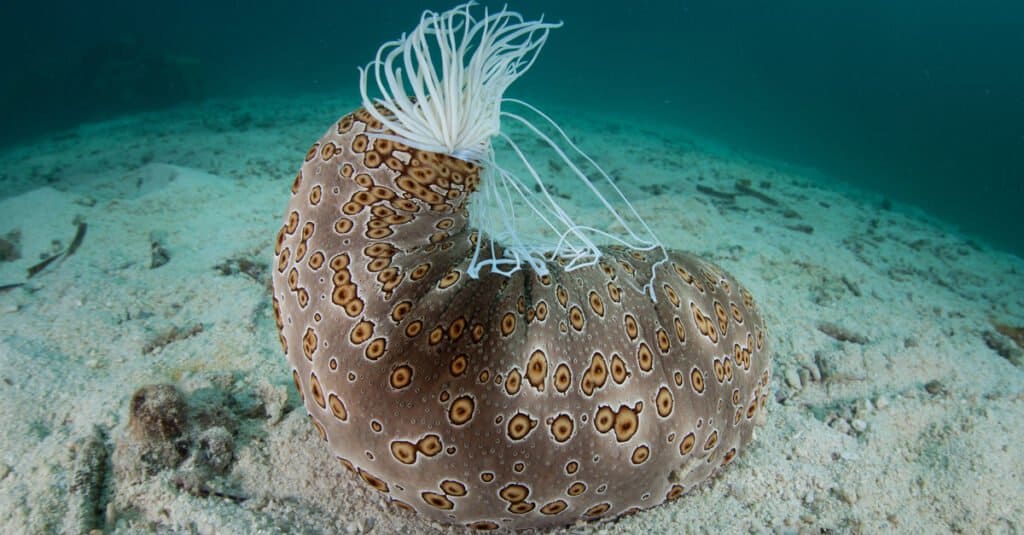
New sea cucumber species join 5,000 others recently found in the Pacific Ocean.
©Ethan Daniels/Shutterstock.com
Scientists have discovered more than 5,000 new species in the Pacific Ocean. These species are at risk because of plans to mine the area for precious minerals. A few creatures include never before seen species of shellfish, sponges, sea cucumbers, and worms.
The 5,000 new species were found in the Clarion-Clipperton Zone (CCZ), a vast region located between Mexico and Hawaii in the Pacific Ocean. It is also known as the Clipperton Fracture Zone and is one of the major submarine fracture zones on the northern Pacific floor.
Mining Operations

Polymetallic nodules found on the ocean floor contain high concentrations of valuable metals.
©V.Gordeev/Shutterstock.com
Along with the new species, valuable minerals are also present, like polymetallic nodules. These nodules, found on the muddy bottom of the zone and in underlying layers, contain various minerals, including nickel, manganese, copper, zinc, cobalt, and more. Mining operations could provide access to these precious minerals.
The minerals are essential for various technological advancements, including electronics and renewable energy technologies. However, deep-sea mining in the CCZ raises concerns about potential environmental impacts. Scientists created a checklist of the species to understand what might be endangered when mining begins.
Hydrothermal Vents in the Pacific Ocean
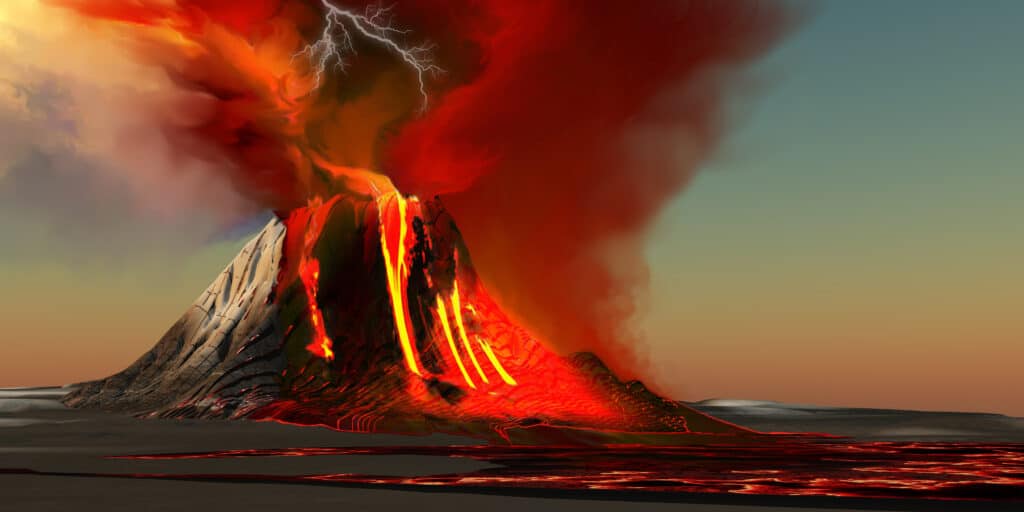
Volcanic heat fuels hydrothermal vents along the ocean floor.
©Catmando/Shutterstock.com
Why are there so many different deep-dwelling sea creatures? Because the ocean floor supports a variety of ecosystems. And they’re made possible by things like hydrothermal vents.
Hydrothermal vents are one of the reasons there’s so much biodiversity at the bottom of the Pacific Ocean. Fueled by volcanic heat, these vents transport heat and chemicals, which creates distinct ecosystems. These vents enable creatures to survive in a lightless world, thanks to the captivating process of chemosynthesis.
Chemosynthesis
Chemosynthesis is a biological phenomenon where organisms use chemicals, rather than sunlight, to generate energy. Unlike photosynthesis, which depends on sunlight as an energy source, chemosynthesis relies on hydrogen sulfide or methane. The process lets sea creatures live in the dark abyss. Tubeworms, giant clams, clam worms, sea anemones, crabs, and shrimp are all fueled by chemosynthesis. These organisms adapt to light-scarce environments like deep-sea hydrothermal vents.
The Abyssal Plain

The abyssal plain is a dark, flatland beneath the ocean waves covering over half of Earth’s surface.
©Golubovy/Shutterstock.com
Imagine a massive, dark, flatland beneath the ocean waves. This is known as the abyssal plain, and it spans more than half of our planet’s surface. This region, which is brimming with a variety of life, plays a vital role in maintaining the balance of our ecosystems. Tools such as submarines and self-navigating underwater drones help aid in the exploration of these deep-sea ecosystems.
Deep Sea Explorers
Jacques Piccard and Navy Lt. Don Walsh were the first to reach the bottom of the Mariana Trench in 1960. They did so inside the bathyscaphe vehicle, which is a type of deep-sea submersible. The deep-sea submersible was named “Trieste” after the city of Trieste in northeastern Italy.
During their descent, Walsh and Piccard observed captivating bioluminescent displays illuminated by tiny glowing creatures that thrived in the abyss. Finally, after hours of descent, the Trieste touched the tranquil seafloor at a staggering depth of 35,800 feet.
Then, in 2019, Victor Vescovo set a new record by diving to a depth of 35,853 feet. During his groundbreaking dive, Vescovo made a disheartening discovery: he found evidence of plastic contamination. That means there’s pollution, even in remote, seemingly untouched areas like the Mariana Trench.
More About the Mariana Trench
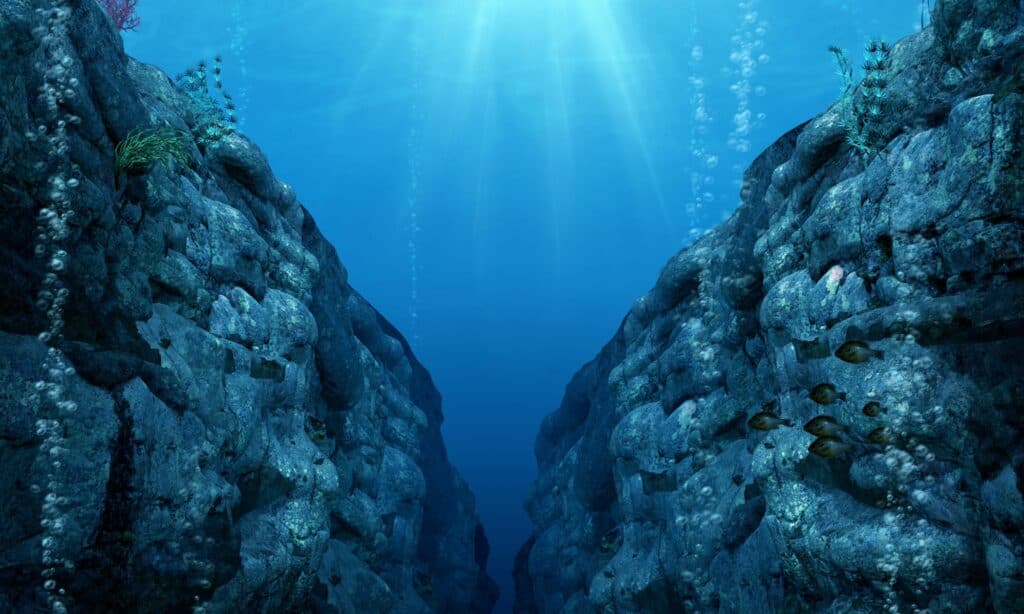
The Mariana Trench is the deepest part of the Pacific Ocean.
©iStock.com/ratpack223
The Mariana Trench is the deepest part of the Pacific Ocean. It was formed by subduction, where one tectonic plate moves under another. It’s 1,584 miles long and contains the Challenger Deep, the deepest point on Earth. This point is 6.85 miles deep and is found near the island of Guam.
Hadal Zone
The Hadal zone is almost 20,000 feet deep. Here you’ll find a variety of larger organisms, such as snipe eels, sea cucumbers, giant isopods, ten-legged crustaceans, bristle worms, shellfish, sea anemones, amphipods, copepods, and abyssal grenadiers.
More Interesting Facts
- Covering an area of 63.8 million square miles, the Pacific Ocean is the deepest ocean on Earth.
- Due to the lack of oxygen and sunlight, no plants exist at the ocean’s bottom.
- The discovery of deep-sea life in the Pacific Ocean dates back to 1818, when Sir John Ross found worms and jellyfish at approximately 2,000 meters.
- Deep sea and space missions share similarities regarding operations and communication challenges, and the learnings from one field can be applied to the other.
- The knowledge gained from deep ocean exploration is being applied to space missions, such as NASA’s upcoming robotic rover mission to the Moon’s south pole.
The photo featured at the top of this post is © superjoseph/Shutterstock.com
Thank you for reading! Have some feedback for us? Contact the AZ Animals editorial team.






